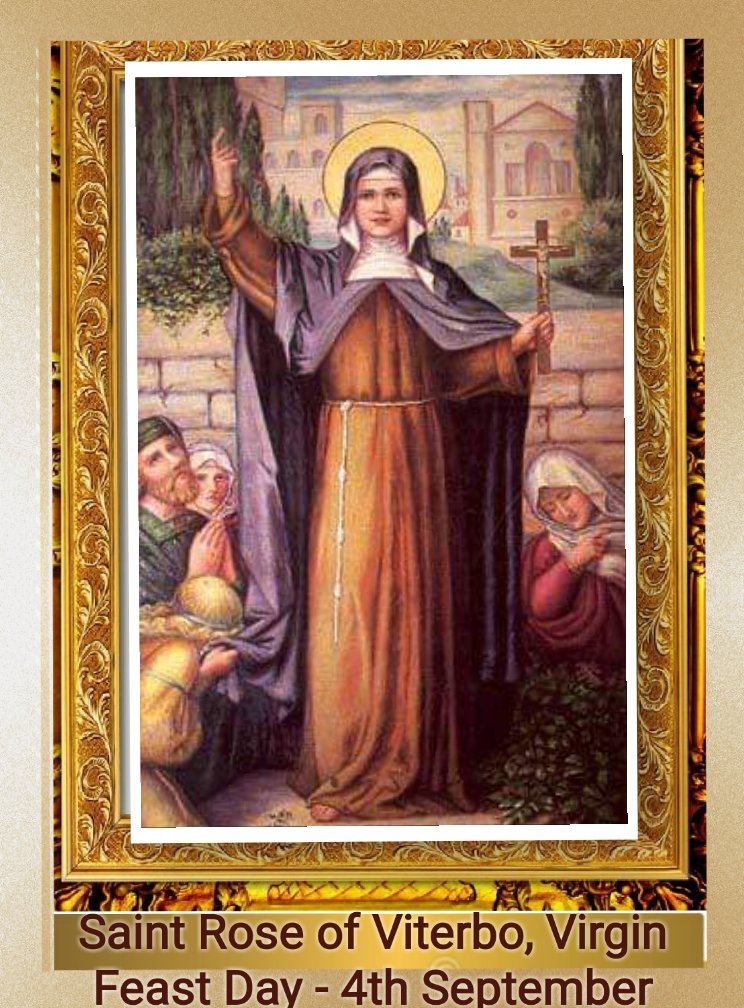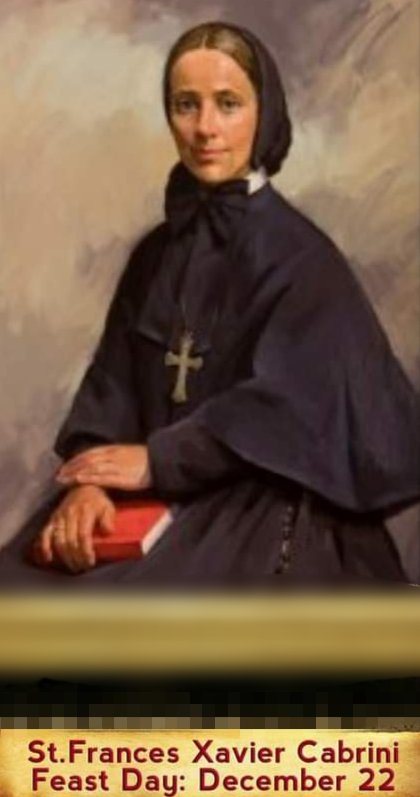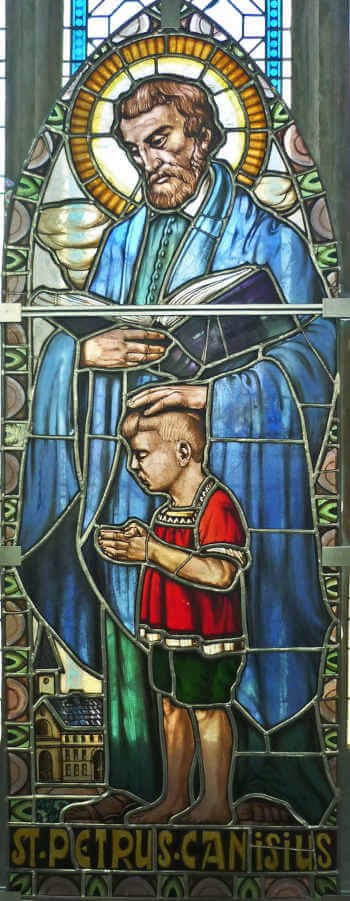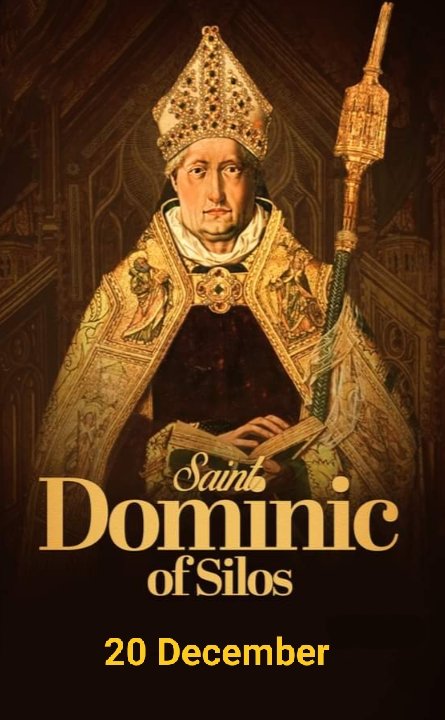
TODAY’S GOSPEL READING – 3 SEPTEMBER
September 3, 2024
Matthew 4:4
September 4, 2024FEAST OF SAINT ROSE OF VITERBO,
VIRGIN
FEAST DAY – 4th SEPTEMBER
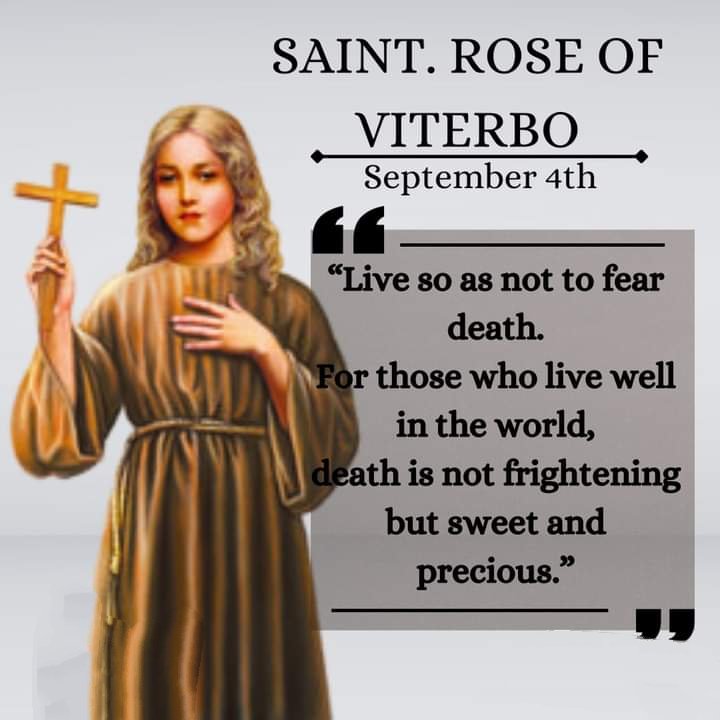
Saint Rose (1235 – 1252) was born in the spring of 1235 at Viterbo, capital of the patrimony of Saint Peter. In those days the emperor Frederick II was oppressing the Church, and many were faithless to the Holy See. But this infant at once seemed filled with grace; she never cried; with tottering steps she sought Jesus in His tabernacle; she knelt before sacred images and listened to sermons and pious conversation, retaining all she heard, and this when she was scarcely three years old. One coarse habit covered her flesh; fasts and disciplines were her delight.
St. Rose was born into a family that was poor but quite devout and she gained a reputation for profound holiness. Her special sanctity was shown when at three years old, she raised her aunt from the dead. As a child she was known for her austere penances and later became a Third Order Franciscan.
Her lively preaching started around age 10 and due to the power of her words, she and her family were temporarily expelled from Viterbo, yet her voice would not be silenced and many souls converted to Christ and His Church. She humbly accepted the rejection she received from a convent she had attempted to join and prophetically said that they would receive her at the convent after she died.
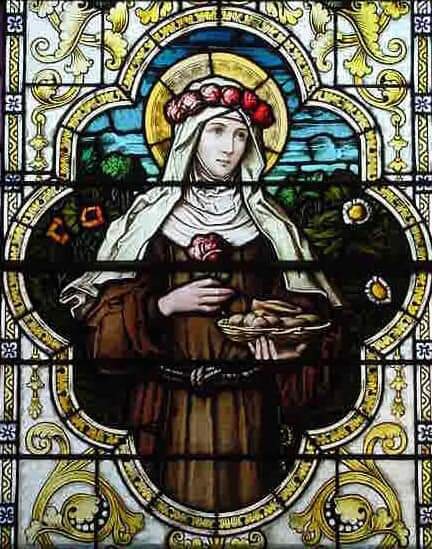
At the age of seven she wished to enter a monastery of nuns; but God had other designs for her, and she resolved to create a solitude in her father’s house, where she would forever spend all her days. Her mortifications there seem incredible to our time of laxity; she gave herself the discipline three times a day until she fainted from fatigue and loss of blood, and she scarcely ate at all. To those who urged her to mitigate her austerities, she explained so perfectly that happiness consists in suffering for God, that no one could doubt this.
Nonetheless she fell ill and nearly died of consumption. She was close to the final agony when suddenly she beheld the Mother of God, and said to those attending her: “All of you here, why do you not greet the Queen of the world? Do you not see Mary, the August Mother of my God, coming forward? Let us go to meet Her, and prostrate ourselves before Her majesty!” Everyone turned toward the door and knelt down, and the Mother of God spoke to Rose, telling her she must enter the Third Order of Saint Francis, then go out to “reprove, convince, exhort and bring back the erring to the paths of salvation.
If your endeavors bring upon you sarcasm and mockery, persecution and labor, you must bear them patiently. Those who assist you will be enriched with all the graces of the Lord.” To defend the Church’s rights was already Rose’s burning wish. When hardly ten years old, she arose after her reception into the Franciscan habit, went down to the public square at Viterbo, called upon the inhabitants to be faithful to the Sovereign Pontiff, and vehemently denounced all his opponents.
She returned to her house only to redouble her flagellations and macerations; she saw her Saviour on the Cross and nothing could arrest her ardor thereafter. So great was the power of her word and of the miracles which accompanied it, that at the end of several months the Imperial party, after threatening her in vain to stop her preaching, in fear and anger drove her from the city.
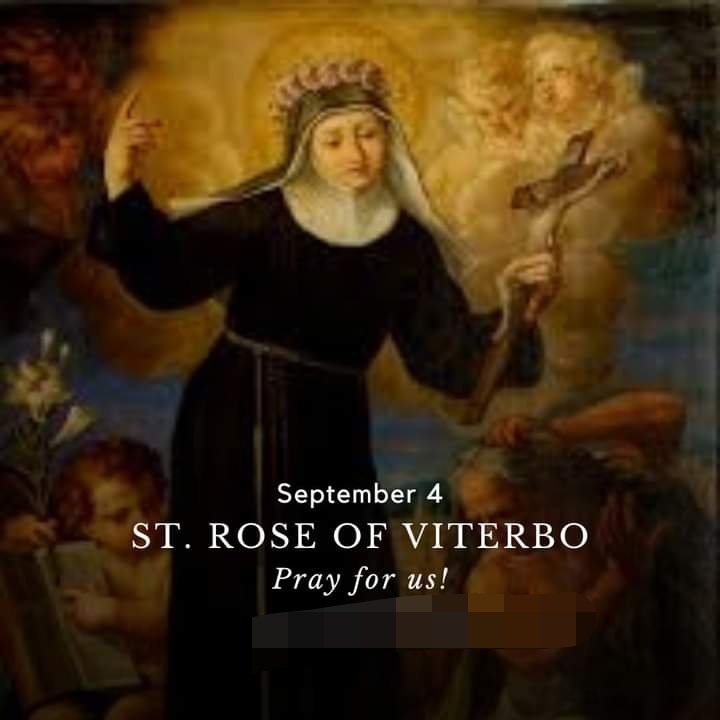
Saint Rose and her parents moved to Soriano, a fortified city, where she continued to do as she had been told by the Mother of God. Then Rose went on by herself to Vitorchiano, where she had understood there was need for her, and continued to win souls by her aspect as much as by her words. She went barefoot and wore a poor tunic at all times, until after some eighteen months, when the emperor had died, she and her parents returned to Viterbo. Innocent IV was brought back in triumph to Rome and the cause of God was won.
A number of young girls came to her for instruction at Viterbo, and she taught them the principles of modest prudence and faithful love of God. Rose fell ill again and recognized that her end was approaching; she prepared, rejoicing, in solitude for her glorious destiny, and died in her eighteenth year. Not long afterward, she appeared in glory to Alexander IV, and bade him to translate her intact body. He found it fragrant and beautiful, as if still in life.
Pope Alexander IV ordered her body laid to rest in the convent that had refused her. For more than 700 years it has remained supple and unchanged, save for its color, darkened after a fire in the chapel where it reposed. She is the Patron saint of people in exile; people rejected by religious orders; Franciscan youth; Viterbo, Italy.
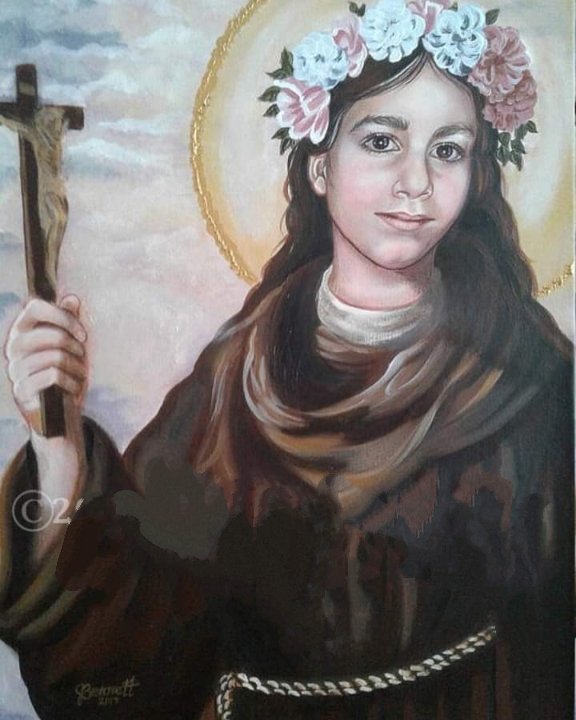
From Les Petits Bollandistes: ‘Vies des Saints’, by Msgr. Paul Guérin (Bloud et Barral: Paris, 1882)
PRAYER
Heavenly Father, Saint Rose gave up everything to devote herself to a life of penance and combined wonderful courage of soul and unsullied innocence. May we imitate the example of her virtues, while celebrating her merits.
Through her intercessory prayers, may we emulate her selfless life on earth and enjoy the fullness of your blessings in heaven. Grant this through our Lord Jesus Christ, your Son, who lives and reigns with you and the Holy Spirit, one God, for ever and ever. Amen
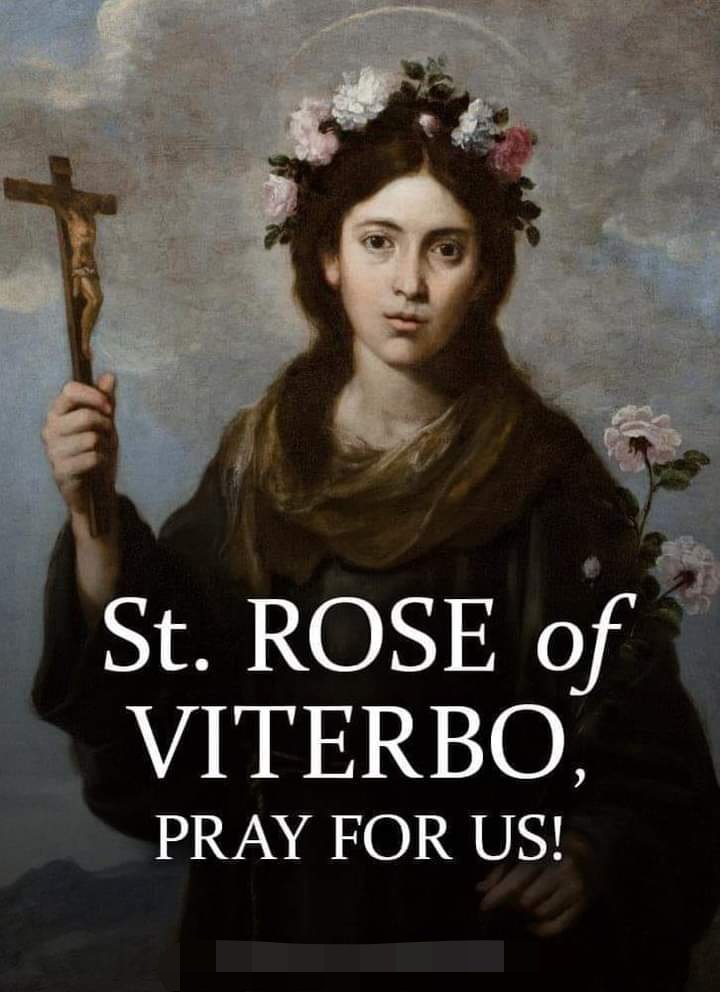
St. Rose of Viterbo, pray for us.
==================================
ALSO CELEBRATED:
FEAST OF SAINT ROSALIA OF PALERMO
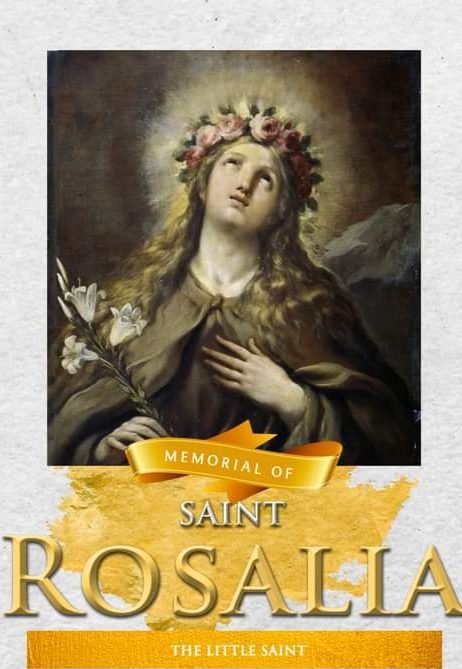
The Hidden Flower of Palermo
Saint Rosalia, affectionately known as “La Santuzza” or “The Little Saint,” holds a special place in the hearts of Sicilians, particularly the people of Palermo. Although she is not as widely known outside of Italy, Saint Rosalia’s life and legacy as a hermit and intercessor during times of plague have made her a powerful symbol of divine protection and steadfast faith. Born into nobility but choosing a life of humility and solitude, she dedicated herself entirely to God, living as a hermit in caves on Mount Quisquina and Mount Pellegrino. Her decision to forsake worldly comforts for a life of penance and prayer reflects her deep devotion to Christ, and her miraculous intercession during the plague of 1624 forever enshrined her as the patroness of Palermo. Often depicted with a crown of roses and a cross, Saint Rosalia reminds us of the beauty and strength found in a life dedicated to God, even in obscurity.
The Noble Hermit
Rosalia was born around 1130 into a noble Norman family in Palermo, Sicily, at a time when the island was a melting pot of various cultures, including Norman, Byzantine, and Arab influences. Her father, Sinibald, was the Lord of Quisquina, and her mother, Rose, was of noble heritage, linking Rosalia to the royal court and even to Charlemagne through her ancestry. Despite the privileges and responsibilities that came with her noble birth, Rosalia was drawn to a different path from a young age. She was known for her piety, gentleness, and a profound desire for a deeper connection with God.
As a young girl, Rosalia experienced a spiritual awakening that led her to renounce her noble status and withdraw from the world. Tradition holds that she was inspired by visions of the Virgin Mary and other saints, guiding her towards a life of prayer and penance. At around 14 years old, Rosalia left her family’s wealth and comforts to live as a hermit in a cave on Mount Quisquina, a remote area that provided the solitude she craved. Later, she moved to another cave on Mount Pellegrino, where she would spend the rest of her days in complete devotion to God. This decision to live as a recluse was not just a rejection of her noble life but a profound expression of her commitment to a spiritual journey that placed God above all else.
A Life of Hidden Sanctity
Though Saint Rosalia did not perform miracles during her lifetime, her existence was itself a miraculous testament to the power of faith and divine love. Living in harsh conditions, she embraced a life of penance, fasting, and continuous prayer, dedicating her solitude to interceding for the world around her. Her life was marked by extraordinary discipline and a steadfast focus on her spiritual mission, embodying the virtues of humility, sacrifice, and unwavering faith.
Rosalia’s decision to live in obscurity, away from the adulation and luxuries that her noble status could afford her, speaks to the hidden nature of her sanctity. She was not seeking the approval of people but the quiet, intimate presence of God. Although there are no recorded instances of miraculous healings or interventions during her lifetime, her life serves as a profound example of how faith and dedication to God’s will can transform an individual into a beacon of holiness, even without public recognition.
A Life of Solitude and Penance
Saint Rosalia’s path was not without challenges. The choice to live as a hermit brought with it the physical hardships of isolation, the constant struggle against the elements, and the inner battles that accompany a life of solitude. These trials were compounded by the spiritual warfare she faced—temptations, doubts, and the human longing for companionship and comfort. Yet, Rosalia embraced these difficulties as opportunities to draw closer to God, offering her trials as a form of spiritual martyrdom. She willingly sacrificed her personal desires and endured the loneliness of her hermitage as a testament to her faith.
Her hardships were a reflection of her commitment to a life of penance, mirroring the ascetic practices of the Desert Fathers and other early Christian hermits who sought God in the wilderness. Unlike martyrs who suffered death for their faith, Rosalia’s martyrdom was a daily, living sacrifice. Her quiet endurance and faithfulness in the face of these spiritual and physical challenges demonstrated her deep trust in God’s providence, and she remained steadfast in her calling until her death in 1166.
The Plague and the Patroness of Palermo
Saint Rosalia’s influence was most profoundly felt after her death, particularly during the plague that struck Palermo in 1624. Almost five centuries after her passing, the people of Palermo were gripped by despair as the plague ravaged the city. It was during this dire time that Rosalia appeared in a vision to a hunter named Vincenzo Bonello. In the vision, she revealed the location of her remains on Mount Pellegrino and instructed him to bring her bones in procession through the city to end the plague. Guided by her words, Bonello found her bones in the cave where she had spent her final days.
Obeying Rosalia’s instructions, the citizens of Palermo carried her relics through the streets, praying fervently for her intercession. Miraculously, the plague ceased, and the city was spared further devastation. This miraculous intervention not only saved Palermo but also solidified Rosalia’s status as a powerful intercessor and the patroness of the city. Her relics became a source of healing and hope, drawing countless pilgrims to Mount Pellegrino, where a sanctuary was built in her honor. The annual “Festino di Santa Rosalia,” held every July, commemorates her intercession with processions, fireworks, and celebrations, reflecting the enduring gratitude of the people of Palermo.
PRAYER
Saint Rosalia, your example challenges us to seek God in the quiet moments of our lives, where our faith can flourish away from the eyes of the world. Your dedication to prayer and penance reminds us that the most meaningful acts of faith may be those that are unseen and uncelebrated by others but are cherished by God.
We can draw inspiration from you, Saint Rosalia by incorporating moments of solitude and reflection into our daily routines, setting aside time to connect with God through prayer, scripture, or simply being still in His presence. May you always be a beacon of inspiration to those struggling with their faith and unbelief. Amen


